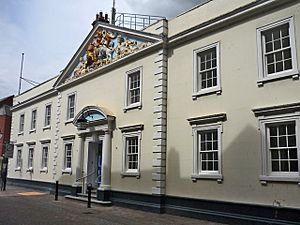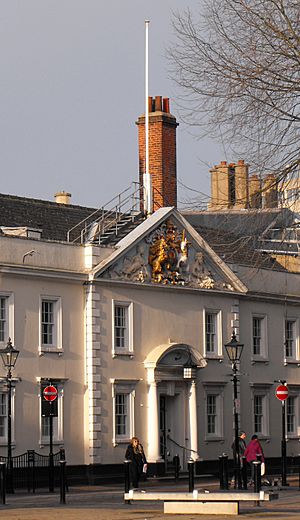Hull Trinity House facts for kids
The Hull Trinity House, often called Trinity House by locals, is a very old seafaring organisation. It includes a charity that helps sailors, a school, and a group of experienced mariners (sailors). This group started as a religious club that helped people in need and built special homes called almshouses. In 1787, they even started a school for young sailors. By the 1700s, they were in charge of important things like managing the harbour in Hull and placing buoys and guiding ships in the Humber Estuary.
After losing many of its duties because of a law called the Humber Conservancy Act in 1852, the group kept working as a charity. They also continued to provide education, which they still do today.
The school, now called Hull Trinity House Academy, is a secondary school just for boys.
The charity part, called Hull Trinity House Charity, helps sailors and their families. It owns properties that help support its work, and it runs rest homes and the Welton Waters Adventure Centre.
Contents
History of Hull Trinity House
The Trinity House was officially started in 1369. Robert Marshall and about 50 other people created a group called the Guild of the Holy Trinity. This was like other religious groups at the time. They would hold church services, attend funerals, and help any sick members. Joining the group cost 2 shillings. At first, it wasn't clearly connected to sea trades.
Early Powers and Growth
In 1457, Edward IV of England gave the guild rights to charge fees called lowage (for unloading goods) and stowage (for loading goods). These fees helped the guild build an almshouse (a home for poor people) and a chapel for 13 people who had become poor because of seafaring problems. It's thought that the guild joined with a 'Shipmans Guild' around 1457. In the same year, they bought the property known as "Trinity House" from some friars. This building was later rebuilt in 1753.
In 1541, Henry VIII confirmed the guild's right to charge lowage and stowage to support the almshouse. He also gave them the right to act as a legal group, meaning they could own property or go to court. This was confirmed again in 1547, 1554, and 1567.
In 1567, Elizabeth I gave the guild powers to solve arguments between ship captains and sailors. They could also stop any sailor they thought was not fit to be in charge of a ship.
Under a new rule in 1581, the guild managed the use of The Haven (which later became the Old Harbour). They also gave licenses to pilots (people who guide ships). They placed buoys and beacons in the River Humber to help ships navigate safely. The right to charge primage, a local import tax, was also given in 1581. By the 1600s, Hull Trinity House controlled most of the rules and fees for the Port of Hull.
In 1625, a senior member of the guild named Ferres started an almshouse called Ferres' Hospital. When he died, the guild took it over.
In 1680, Charles II of England named the guild as the managers of the Haven. He also confirmed their right to charge primage, place buoys, appoint pilots, and make their own rules.
The main Trinity House Building was rebuilt in 1753. A guild house was added in 1775. The buildings were made of brick with fancy fronts, in a style called Tuscan. Statues of Neptune (the Roman god of the sea) and Britannia (a symbol of Britain) were placed above the main entrance. The building formed a square around a courtyard, with almshouse rooms around it. By 1835, the guild owned several other almshouses in the town.
Influence and Changes
Trinity House became a very important group in Hull during the 1600s, 1700s, and 1800s. It had some say in town matters and supported or opposed new laws in parliament about the town's trade and port. The guild helped start the Hull Dock Company. It also provided half the money for the Humber Dock and supported the creation of the West Dock Company. During this time, members of Trinity House were often present when kings, queens, or other important people visited Hull. The guild also had authority over other ports like Bridlington and the Port of Grimsby. Its members were asked for advice by the government on sea-related issues.
During the late 1500s, 1600s, and 1700s, the guild both supported and opposed plans to build lighthouses at Spurn and Flamborough. Laws in 1766 and 1772 put lighthouse building under the control of the London Trinity House. However, the Hull guild was still in charge of lighting and keeping them working. All these duties passed to the London guild in 1836.
In 1810, a lifeboat station was set up at Spurn Point. It was paid for by donations, and the Trinity House provided the crew. The lifeboat became the responsibility of the Humber Conservancy Board in 1908.
The guild was most powerful during the Napoleonic era (early 1800s). It even faced criticism in newspapers. In 1852, the guild lost its special control over the Humber with the Humber Conservancy Act. It also lost its rights to lowage, stowage, and special pilotage rights in the 1800s. After losing much of its power over shipping and guiding ships, the guild continued its work helping people and providing education.
Trinity House School
In 1785, a school for marine studies was started on the Trinity House property. A new building was built next to the chapel, and the school opened in 1787 with 36 boys. The students learned reading, writing, accounting, religion, and navigation for three years. After that, they became apprentices (trainees) in a trade.
The school moved to a new building in 1842. It was split into a lower and upper school in 1849. By 1856, the school taught 98 boys, and by the 1870s, it had 180 students.
By the second half of the 1900s, the school (called 'Trinity House Navigation School') had become an independent secondary technical school. The school was updated in 1956. In 1963, it had 180 students and was still at its 1842 location. A third floor was added to the school in 1973.
The school gained "specialist" status in 2008, meaning it focused on certain subjects. In 2012, it became an academy. In 2013, the school moved to a new site on George Street. It uses a renovated building that used to be part of the University of Lincoln.
In 2014, the old school building was approved to be taken down. The site of the old school is now a car park and events area called Zebedee's Yard.
Images for kids





